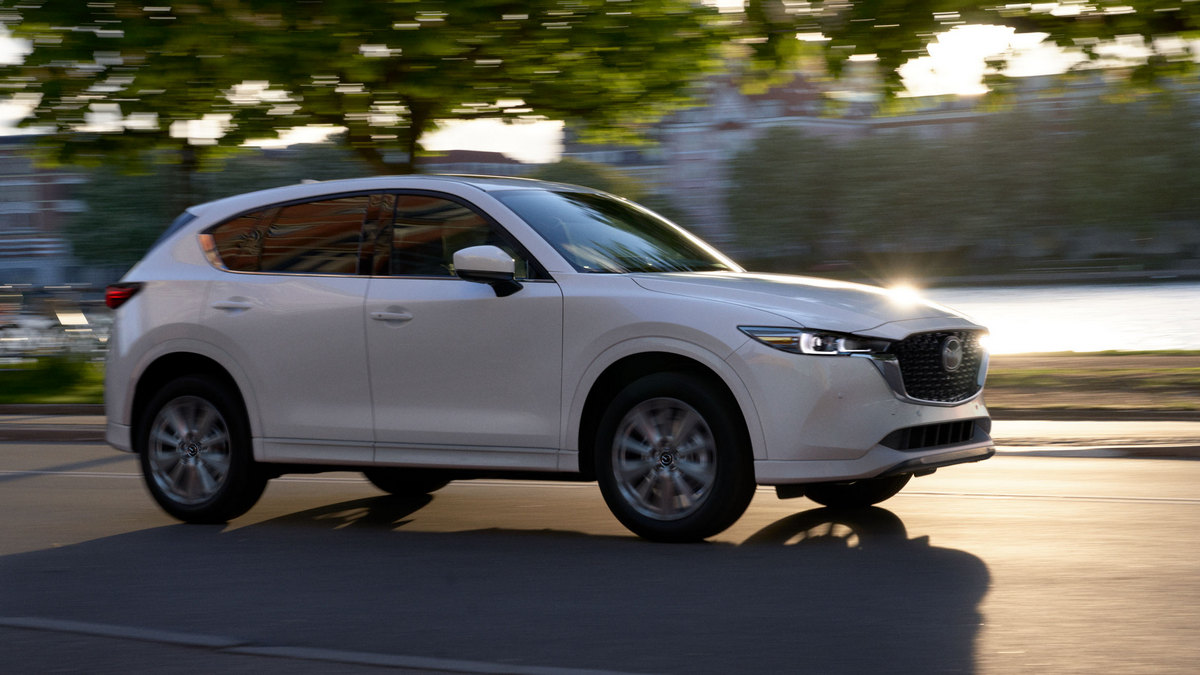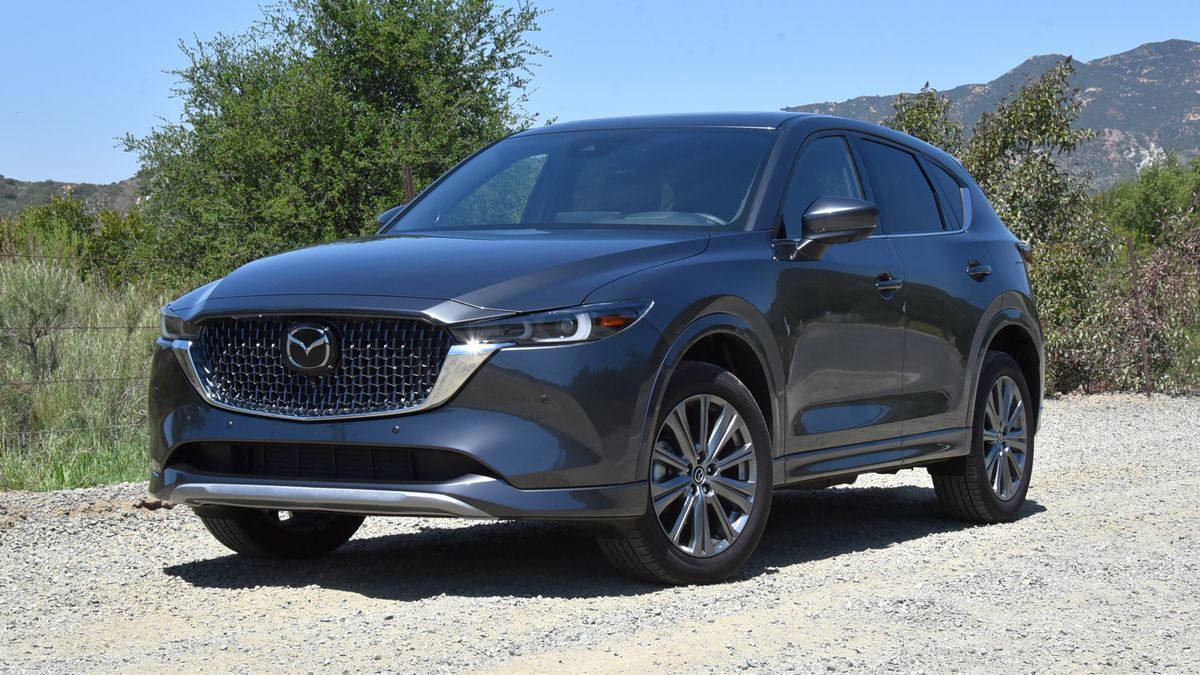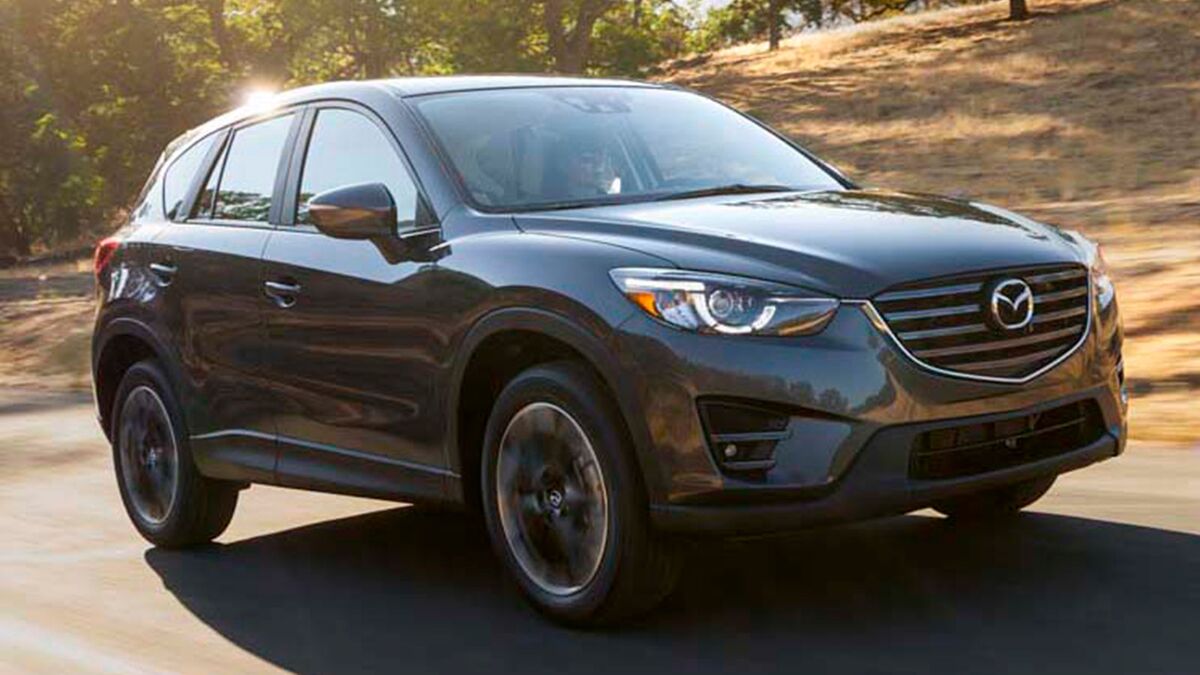Used Mazda CX-5 Quick Facts
- The best years for buying a used Mazda CX-5 are 2020-2025.
- The CX-5 is known for its excellent handling and performance abilities.
- First-generation CX-5 models offered the option of a manual transmission.
The Mazda CX-5 isn’t like other compact SUVs. Its sporty styling matches its ability to carve corners like a low-slung sports car, and its upscale interior belies its modest price range. The CX-5 isn’t as roomy as a Subaru Forester or Toyota RAV4, and its fuel economy is far from class-leading. However, the second generation’s optional turbocharged engine provides the kind of acceleration few competitors can match, and the Mazda CX-5’s relatively strong record of reliability and good resale make it a good used choice.
- What Is the Best Model Year Used Mazda CX-5?
- Mazda CX-5 by Generation: Which Should You Buy?
- Is the Mazda CX-5 a Good SUV?
- Does the Mazda CX-5 Have a Good Resale Value?
- How Much Can the Mazda CX-5 Tow?
- What Are the Most Reliable Years for the Mazda CX-5?
- What Are the Worst Years for the Mazda CX-5?
What Is the Best Model-Year Used Mazda CX-5?

A late model 2020-2025 CX-5 is your best bet. It features the latest driver-assist, audio, and safety systems. Depending on the year and mileage, the SUV may still be under the factory warranty. If your budget is tight, a first-generation CX-5 is also a safe bet, although we’d go with a 2015 or 2016 for its better reliability ratings. Although Mazda didn’t offer Apple CarPlay or Android Auto until 2019, it offers a retrofit kit for any 2014 or newer CX-5 equipped with the Mazda Connect infotainment system.
See used Mazda CX-5 SUVs near you.
Mazda CX-5 by Generation: Which Should You Buy?
Second Generation: 2017 – Current

The second-generation CX-5 improves over the first, offering more powertrain options, better tech, and cutting-edge driver assist systems. The overall size and powertrain choices mostly carry over from the previous year, although Mazda drops the manual transmission and introduces a new 250-horsepower turbocharged engine. There’s also a one-year-only diesel engine option that appears for 2019.
We like this generation because it may still qualify for Mazda’s certified pre-owned program (CPO), which includes a thorough vehicle inspection and additional warranty coverage.
RELATED: Is a CPO Warranty Worth It on a Reliable Car?
Mazda offers plenty of choice. The trim ladder starts reasonably enough, with three models: Sport, Touring, and Grand Touring. However, over time, the CX-5’s lineup grows to eight trims, including the Select, Preferred, Premium Plus, and turbocharged Signature, Premium, Grand Touring Reserve, and Carbon Edition.
Power for the non-turbo models comes from a 187-horsepower 2.5-liter 4-cylinder engine paired with a 6-speed automatic transmission. Front-wheel drive (FWD) comes standard, with all-wheel drive (AWD) optional.
The base Sport trim features 17-inch alloy wheels, LED headlights, manual air conditioning, a 7-inch touchscreen for the Mazda Connect audio system, keyless entry with push-button start, cruise control, and low-speed forward emergency braking.
The Touring adds rear privacy glass, auto-leveling headlights, a 6-way power-adjustable driver’s seat, heated front seats, leatherette upholstery, dual-zone automatic climate control, proximity keyless entry, a blind-spot monitor, and rear cross-traffic alert.
The Preferred Equipment and iActivsense packages are optional on the Touring. The Preferred package includes automatic headlights, rain-sensing wipers, a 10-speaker Bose audio system, a power moonroof, a power tailgate, and navigation.
The iActivsense upgrade adds important driver assists, such as auto high beams, rain-sensing wipers, adaptive cruise control, lane-departure warning, lane-keeping assist, and emergency braking.
The Grand Touring includes features from the Touring’s optional packages, then adds 19-inch wheels, adaptive headlights, LED fog lights, leather upholstery, driver’s seat power lumbar, and heated side mirrors.
The Grand Touring offers an optional power passenger seat, memory for the driver’s seat and mirrors, a head-up display, traffic sign recognition, heated rear seats, a heated steering wheel, and a windshield de-icer.
Model Year Changes:
2025: S trim returns, and the Premium Plus gets more standard equipment.
2024: Mazda drops the S trim and adds the Carbon Turbo.
2023: No significant changes.
2022: Standard all-wheel drive (AWD) and updates to the seats, suspension, and transmission improve the driving experience. Mazda changes the Grand Touring Reserve name to Turbo.
2021: New standard features include Apple CarPlay/Android Auto, Mazda Connect, off-road brake assist, and a 10.25-inch touchscreen display. The Signature trim gains a 360-degree monitor and smart rear braking.
2020: iActivsense driver assists made standard, and the Sport trim gains more standard equipment. Mazda drops the diesel engine option.
2019: A diesel engine option joins the lineup, while the Signature and Grand Touring get a new 250-hp turbocharged 2.5-liter engine. Apple CarPlay/Android Auto arrive as options, along with ventilated front seats and a surround-view camera.
2018: The Sport trim gains a blind-spot monitor and rear-cross traffic alert, while the Touring gets the iActivsense suite.
The CX-5 has a relatively good record when it comes to reliability. Some areas of concern revolve around soft brake pedal feel (2017-2018), windshield cracks (2017-2020), lagging performance for Apple CarPlay and Android Auto (particularly with the optional upgrade), excessive oil consumption, and carbon buildup (turbocharged engines).
See 2017 to current Mazda CX-5 SUVs near you.
First Generation: 2013-2016 Mazda CX-5

The first-generation Mazda CX-5 is as noteworthy as the second. For most of its run, it has enjoyed a good reputation for reliability, with only a few issues on the first-year models. Although it lacks some advanced driver assistance and infotainment features of the second-gen CX-5, the first generation still ranks high in safety, crash test scores, fuel economy, and, most importantly, driving enjoyment.
As with the second-gen CX-5, the first generation isn’t big on rear seat legroom and cargo space, but it’s not unlivable. This generation has two engines: a 155-hp 2.0-liter 4-cylinder and a 184-hp 2.5-liter 4-cylinder. The base model with the 2.0-liter engine offers the option of a 6-speed manual or 6-speed automatic; the 2.5-liter is an automatic-only proposition.
The base Sport features the 2.0-liter engine, power windows, power door locks, keyless entry, cruise control, and air conditioning. The Touring adds a 6-way power driver’s seat, a blind-spot monitor, 5.8-inch touchscreen audio, Bluetooth, and a rear backup camera. The Grand Touring adds goodies like a power moonroof, Bose audio, dual-zone climate control, and 19-inch wheels.
Options vary by trim and include adaptive xenon headlights, navigation, proximity keyless entry, and, on the Touring trim, the Bose audio system and sunroof package.
Some common issues for the first gen closely mirror the second and include cracked windshields, excessive oil consumption for the 2.5-liter engine, soft brake pedal, glitchy touchscreen infotainment, and a recall issued for the daytime running lights that may fail due to a bad circuit board.
Model Year Changes:
2016: The 2.5-liter is made standard on all but the base Sport trim with the manual transmission.
2015: Touring and Grand Touring gain proximity keyless entry.
2014: A 2.5-liter engine is made standard on the Touring and Grand Touring trims. Smart City Brake Support (low-speed automatic emergency braking) is also optional on the two upper trims.
See 2013 to 2016 Mazda CX-5 SUVs near you.
Is the Mazda CX-5 a Good SUV?
Overall, the CX-5 is a very good used SUV choice. It’s not the roomiest nor the most fuel efficient, but it has a good reputation for reliability, features a competent all-wheel-drive system, and delivers sports-car-like ride and handling.
Does the Mazda CX-5 Have a Good Resale Value?
The CX-5 has better-than-average resale values. It is not quite up to spec with the Honda CR-V or Toyota RAV4, but its numbers are on par with those of the Subaru Forester and better than those of the Ford Escape, Kia Sportage, Nissan Rogue, and Chevrolet Equinox.
How Much Can the Mazda CX-5 Tow?
When equipped with the 2.0-liter engine and automatic transmission, the CX-5 can pull up to 1,500 pounds. Models with the 2.5-liter and turbo can pull up to 2,000 pounds, while the short-lived diesel can pull 3,000 pounds.
What Are the Most Reliable Years for the Mazda CX-5?
The best years for the CX-5 are 2020-2025, and 2015 and 2016 for the first generation.
What Are the Worst Years for the Mazda CX-5?
The most problematic years tend to be the first few for each generation. 2013 and 2014 have more than the following years, as do the 2017 and 2018 versions of the second generation. However, none of the known issues are severe enough to have us recommend avoiding them at all costs; just be aware of the potential for possible repair work. 2014-2016 CX-5s with the 2.5-liter engine may experience excessive oil consumption due to premature wear of the rings and valve seals.











